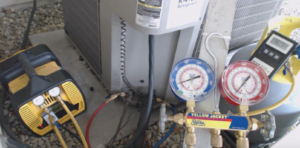Refrigerants is bad for the environment because it harms the ozone layer. Specifically chlorine causes ozone depletion. Ozone is critical because it protects us from ultraviolet radiation. The Montreal Protocol calls for a production phase out of Chlorofluorocarbons (CFC). As a result of the international agreement, the ozone hole in Antarctica is slowly recovering with full recovery expected by 2050.
The Federal Clean Air Act requires all persons working on refrigerants be certified in recovery procedures. The cylinders must be SAE approved. After charging a system using manifold gauges the refrigerant in the hoses must be recovered.

Significant New Alternatives Policy (SNAP) Program
Before retrofitting a motor vehicle AC system ensure that the replacement is EPA – SNAP approved.
Service hoses must be within 12″ with the end of the house. When disposing of an empty cylinder, you must attach the cylinder to the recovery unit, reduce the cylinder to a vacuum and mark the cylinder empty.
Note: It is illegal to vent refrigerant because it depletes the ozone layer.
Recovery cylinders must not be filled above 80% of their capacity and the safe filling capacity can be controlled by